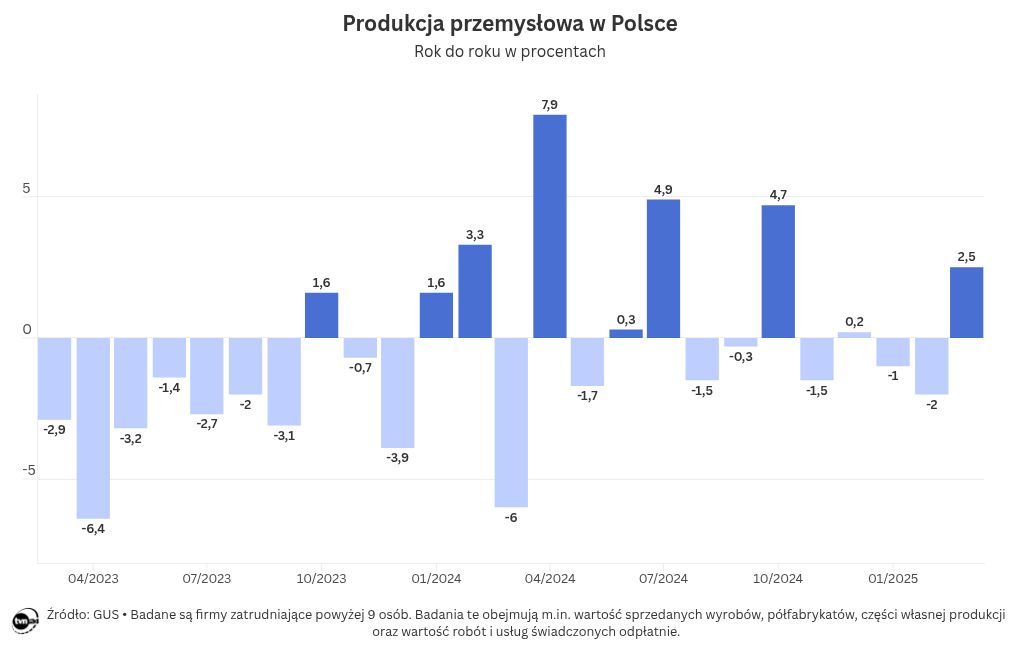Biznes Fakty
The prognosis is getting worse. „There is a high risk”

The International Monetary Fund has adjusted its forecast for Poland’s economic growth down from 3.5 to 3.2 percent. Analysts from Credit Agricole and ING Bank Śląski have highlighted the potential effects of tariffs imposed by Donald Trump on Poland’s GDP.
The International Monetary Fund (IMF) has revised its projections for Poland’s GDP growth in 2025 from 3.5 percent to 3.2 percent, and for 2026 from 3.3 percent to 3.1 percent, as stated in the IMF’s cyclical report titled „World Economic Outlook”.
This year, the IMF predicts that inflation in Poland will be at 4.3%. Nevertheless, Poland is expected to remain one of the fastest growing economies within the European Union, with only Malta anticipated to achieve higher growth rates.
Poland’s GDP forecasts
Jakub Borowski, chief economist at Credit Agricole, noted that the industrial and wage statistics released on Tuesday suggest „a gradual decline in wage pressure” and „a slower-than-anticipated recovery in domestic demand.” He acknowledged that this poses a risk of GDP growth in Q1 2025 falling short of CA’s estimates.
Read also: This is how much we earn >>>
„The downward risk factor for the expected GDP trajectory in the upcoming quarters still hinges on the customs policies of the Trump administration. Although Poland’s exposure to this risk is relatively minimal (…), we believe that a significant increase in tariffs in the US and the EU, resulting in a substantial decrease in trade between the two economies, could prompt us to lower our GDP growth forecast for Poland (3.5%),” stated Jakub Borowski.
„This data reinforces our expectation that the Monetary Policy Council will reduce interest rates by 50 basis points in May,” he added.

Economists from ING BSK have also pointed out the implications of Donald Trump’s customs policies in their analysis.
„Regardless of the final form of the new tariffs among the world’s leading economies, there is a significant risk of a negative impact stemming from increased uncertainty regarding international trade conditions, which is likely to result in reduced investment and consumption. Domestic demand will continue to be the main driver of growth in the Polish economy; however, we have adjusted our GDP growth forecast for 2025 from 3.5% to 3.2%. The risks to economic growth in 2026 are also increasing,” the analysts stated.
Trump Tariffs and Economic Forecasts
The IMF has revised its global growth forecast from 3.2 percent to 2.8 percent for this year and from 3.3 percent to 3 percent for the following year. The tariff conflict instigated by the US is anticipated to influence the prospects of nearly all economies worldwide.
The repercussions of Donald Trump’s tariffs and retaliatory measures will be felt most acutely in the United States, where projected growth has been downgraded by 0.9 percentage points to 1.8 percent. Unlike many other analyses, the IMF does not foresee a recession in the United States. However, during a press briefing regarding the new report, IMF Research Director Pierre-Olivier Gourchon acknowledged that the institution’s assessment of recession risk in the US has risen from 25 to 40 percent due to the tariffs. The tariffs are also expected to complicate efforts to combat inflation, which is projected to revert to last year’s level of 3 percent.
China is also expected to face significant challenges due to the tariffs; the Fund anticipates that its economy will grow by 1.25 percentage points, though this effect may be softened by Beijing’s fiscal policies. Overall, China’s growth in 2025 is now estimated at 4%, down from a previous forecast of 4.6%. Ironically, the tariffs are likely to further diminish inflation in China, raising the risk of deflation.
One of the few nations with upwardly revised forecasts is Russia, which has been exempted from Trump’s tariffs. Its economy is expected to expand by 1.5% this year, slightly above the initial estimate of 1.4%. The IMF also projects Ukraine’s growth at 2%.
When asked if Trump’s tariffs could yield any positive economic outcomes, or if the US president might actually be a „genius” who perceives more than the experts, IMF economists expressed their belief that the tariffs would have a lasting detrimental effect on the global economy.
The long-term consequences of the tariffs, should they persist, would be “negative for all regions, just as the short-term impact.” “Thus, we anticipate negative effects in the short, medium, and long term,” Gourchon concluded.



